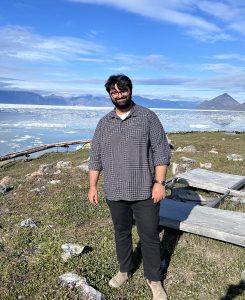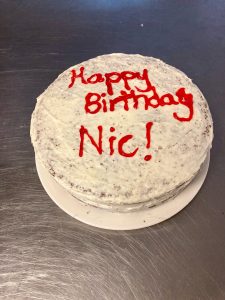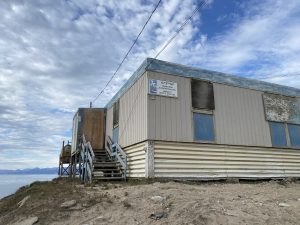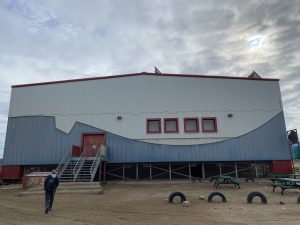By Nicolas Kamran
On my twenty-first birthday, I saw a man go to prison. I parsed through our client’s criminal record again as the sheriffs carried him away. At this stage, he had seen the inside of a courtroom more often than most big law firm associates. “Courtroom,” I use in the broadest sense. We stood inside a community center that held court only because that was what we demanded of it. For others, it was a hockey rink, sometimes a concert venue. To our client, I wondered if it had been anything else but a border post between lands of freedom and captivity, and myself but one more sad customs officer.
To look out anywhere in Mittimatalik (Pond Inlet) is to see mountains cut across the sky. They had surrounded me for the past week, reflecting on the Arctic Ocean those same stark lines of grey and white immortalised by Frederick Varley. A century ago, those mountains stood over one of the most consequential trials in world history.[1]

Robert Janes, by all accounts, was a deeply troubled man. The Newfoundlander’s career as a sailor was marked by failure and isolation in Mittimatalik, where he once claimed to have struck literal gold. His reports of fortune had even received enough attention to have three ships sail to Pond Bay—one sank, two returned, none found gold. By 1919, however, Janes had found moderate success as a trapper. He had spent the past three years selling fox skins across the East Arctic in various Inuk hunting camps, garnering a reputation as an imposing, erratic, and violent fur-trader. The truth was that Robert Janes had gone mad. At times, his body would rattle with rage. Other moments he spent ruminating in his igloo. He was so desperate to fund his passage home that he began demanding hunters give up their skins to him, threatening death in case of refusal. For the Inuit living in the hunting camp, his aggression inspired fear and demanded reaction.
It came down to self-defence: Robert Janes needed to die. The Inuit conversed for hours until an elder conclusively argued that he should die before he had the chance to kill one of them. Having reached this consensus, the community selected the young hunter Nuqallaq for the task. On March 15, 1920, he ambushed Janes and shot a bullet in his skull. Along with two fellow hunters—Ululijarnaat and Aatitaaq—Nuqallaq buried him in a shallow grave off the shore of Eclipse Sound.
A wave of relief fell over the camp as fellow hunters celebrated Nuqallaq. For saving the community from the threats of this abrasive trader, several even gifted him their skins. Inuit customary law had directed the group to dispose of Janes in such a manner, and consensus had guided them every step of the way. Nuqallaq was the procedural vessel for executing the camp’s decision. He restored the order Janes had undone. With all in the community speaking freely of the killing, passing ships slowly brought the news south.
In 1920, the imperially misguided question of who “owned” the Arctic remained open. The Inuit had been spread over what we today call Greenland, Northern Canada, Siberia, and Alaska for at least 4000 years, sharing a common culture and the Inuit–Yupik–Unangan language family. Nunavut translates to “our land,” a rather unambiguous claim—though some argue that Inuit societal values may not exactly square with ideas of sovereignty under public international law. Even so, Canada’s answer to this paragraph’s initial question has borne greater resemblance to Robert Janes than to Nuqallaq.


Iqaluit was known as Frobisher Bay until 1987. The name honoured Sir Martin Frobisher, the English seaman and privateer who came across the bay in 1576 when searching for the North-West Passage. Like Janes, Frobisher was convinced that he had discovered vast quantities of gold. He returned to the territory on several occasions, digging up mines and transporting thousands of tons back to England. Once smelted, the ore revealed its true nature: hornblende, a worthless mineral used today for highway construction. The name “Baffin Island” honours William Baffin, another English seaman who came looking for the North-West Passage in 1616—before dying alongside my ancestors in the Conquest of Ormuz. Most famously, the “Franklin strait” takes its name from Sir John Franklin, the British Royal Navy officer whose failed Arctic expedition became an international media sensation. After disappearing in 1845, his wife Lady Jane Franklin sponsored seven expeditions to the arctic in hopes of discovering her husband’s fate. For the next 170 years, explorers and scientists across the world attempted in vain to find Franklin’s lost expedition. In 2014, a Parks Canada team finally came upon the wreck of Franklin’s HMS Erebus in Nunavut. Prime Minister Stephen Harper announced the discovery in the House of Commons, expressing his gratitude to Franklin for laying the foundation to Canadian sovereignty in the Arctic. Franklin’s memorial stands tall in Westminster Abbey, bearing the inscription: “Discoverer of the North West Passage.” For centuries, the Inuit had named the strait where emerged HMS Erebus “Umiaqtalik,” meaning “there is a boat there.”
Exploration notwithstanding, Canada’s claim to the Arctic was weak in the early twentieth century. The British had never consistently occupied the archipelago, and the Federal government was not terribly worried about asserting its sovereignty in the region for lack of challengers. This situation changed when American and Norwegian explorers began declaring ownership of “undiscovered islands” in the Arctic.[2] Pressure mounted in Ottawa. Canada needed to show the world that it would enforce its own laws in the Arctic islands. When word of Robert Janes’ death reached RCMP commissioner Aylesworth Bowen Perry—erstwhile Canadian militia major during Louis Riel’s North-West Rebellion of 1885—sovereignty was set in motion.
It did not take long for Staff-Sergeant Alfred Herbert Joy to get settled in Mittimatalik. A few months after receiving orders to investigate Janes’ case in 1921, he successfully located the body, prepared an autopsy, conducted an investigation, arrested the accused, and set a trial for August 1923. The judge would find Nuqallaq guilty of manslaughter and sentence him to 10 years in Stony Mountain Penitentiary—the same prison where Chiefs Big Bear, One Arrow, and Poundmaker languished after the 1885 North-West Rebellion. There, Nuqallaq contracted tuberculosis within months before being sent back to Baffin Island, having brought his disease along with him. Tuberculosis remains a deadly scourge in Nunavut. In 2014, Stony Mountain Penitentiary opened its new $45 million maximum-security wing.

It is not an exaggeration to say that Canadian sovereignty in the Arctic was founded upon crime and punishment. Staff-Sergeant Joy built the community’s first RCMP detachment and courthouse, the former of which would soon be stationed next to the first Hudson’s Bay Company (HBC) trading post in the High Arctic. In the wake of the Janes killing, the RCMP set up permanent detachments and patrols across the North, each followed soon by the HBC. By 1930, Canada paid off the last Norwegian land claim to the territory. What had been set in motion was now complete.
Thoughts of Nuqallaq and Robert Janes swirled about in my head as I looked once more to the mountains. Earlier that day, I had interviewed a client for sentencing. With our backs against a field hockey installation, he spoke softly of his upbringing in Mittimatalik. I sensed with every word how it was impossible to know our client without understanding what his grandfather had meant to him. He had been the root upon which my client could grow and flourish, fixed deeply in the soil but connected to all. When he passed away, my client felt as though he could no longer stand. He withered. I thought of my own grandfather, born the same year Staff-Sergeant Joy began his investigation. Sleep seemed out of reach for the night. It remained so when news reached my supervising lawyers that the upcoming circuit in Grise Fiord had been cancelled.

If Mittimatalik was founded on a trial, Grise Fiord was founded on a lie—though both rose from Canada’s shameless quest for sovereignty. In 1953, the Canadian government coerced eight Inuit families from Inukjuak to settle on the southern tip of Ellesmere Island (Grise Fiord) and the northern coast of Cornwallis Island (Resolute). Prime Minister Louis Saint-Laurent sold the “Arctic relocation program” as a humanitarian gesture to save the Inuit from starvation, promising them homes, abundant game, and the opportunity to return to northern Quebec after two years. In what would become Canada’s coldest and northernmost public communities, they found no buildings, scarce wildlife, and no way home. The Canadian government treated the Inuit as mere human flagpoles; in more ways than one, the “relocated” and their descendants wait for justice—no officer of the Nunavut Court of Justice has been to Grise Fiord in two years.[3]
Returning to McGill will be difficult after three months up north. An unstructured or poorly considered argument when submitted for a law school assignment yields at worst a bad grade. An unsound strategy in court may cage your client for several years. The comically stark difference in stakes requires adaptation. Working in criminal justice also tends to reveal how “meritocracy” simply acclaims the fortunate, or those with the means to escape accountability for their worst moments. Mostly, I will need to adjust my perspective on time. The first twenty-one years of my life have been spent looking forward—the next opportunities, places and ideas. I have taken immobility as regression. In turn, Nunavut landscapes often gave me a feeling of eternity. I had the unmistakable impression that generations before me had looked upon the same tundra and would do so far past my death. If I looked closely enough, Nuqallaq and Robert Janes were right there. In Nunavut I walked with History.
[1] My telling of the Robert Janes trial owes much to the following works: Shelagh Grant, Arctic Justice: On Trial for Murder, Pond Inlet, 1923 (Montreal, QC: McGill-Queen’s, 2002); Kenn Harper, Thou Shalt Do No Murder: Inuit, Injustice, and the Canadian Arctic (Iqaluit, NU: Nunavut Arctic College, 2017). More information can be found in the Qikiqtani Truth Commission’s community history of Mittimatalik.
[2] See generally William James Mills, Exploring Polar Frontiers: A Historical Encyclopedia (Santa Barbara, CA: ABC-CLIO, 2003).
[3] Fall 2022 should see a circuit in Grise Fiord and Resolute.

